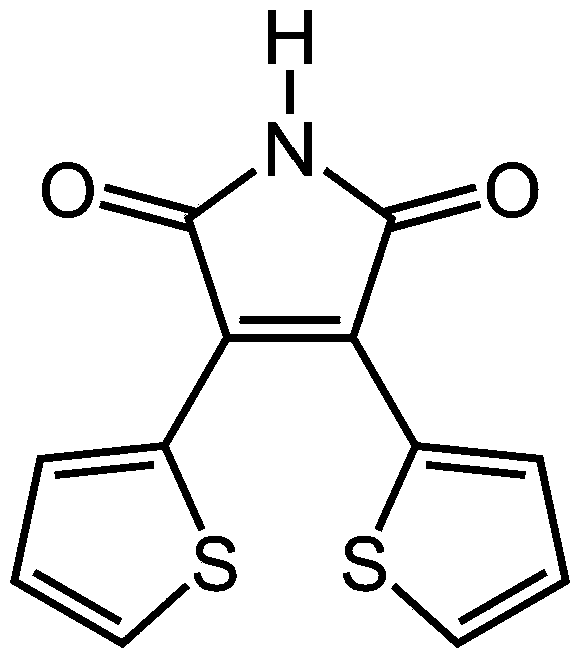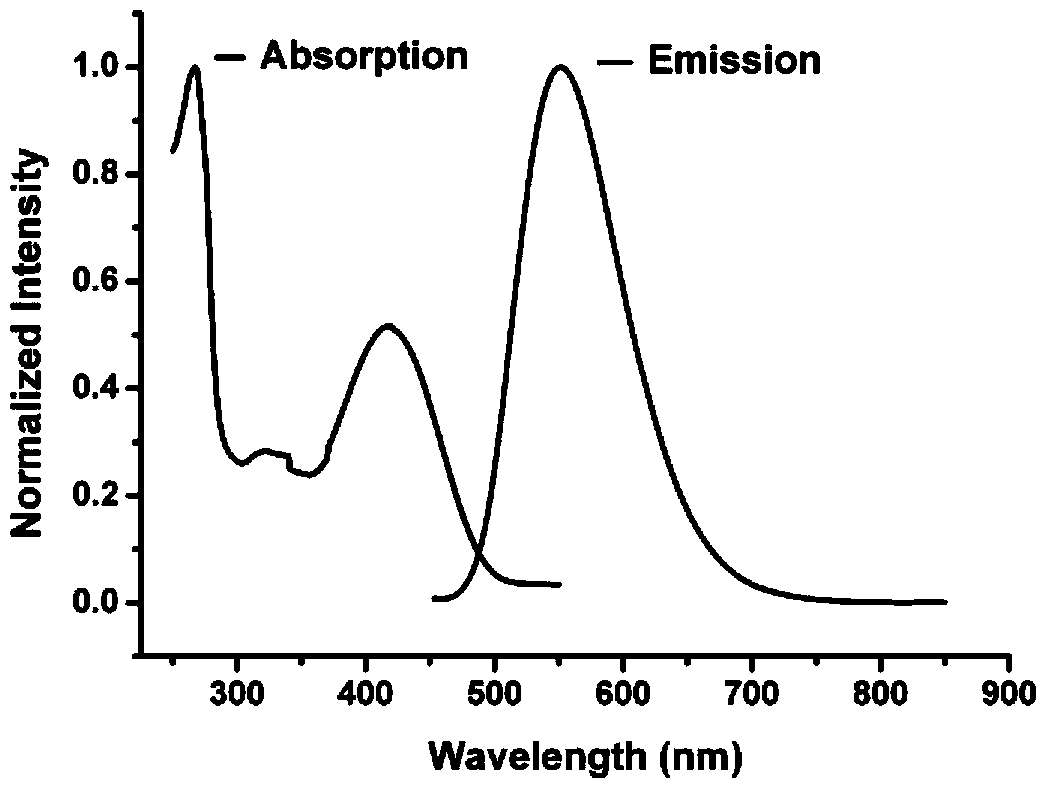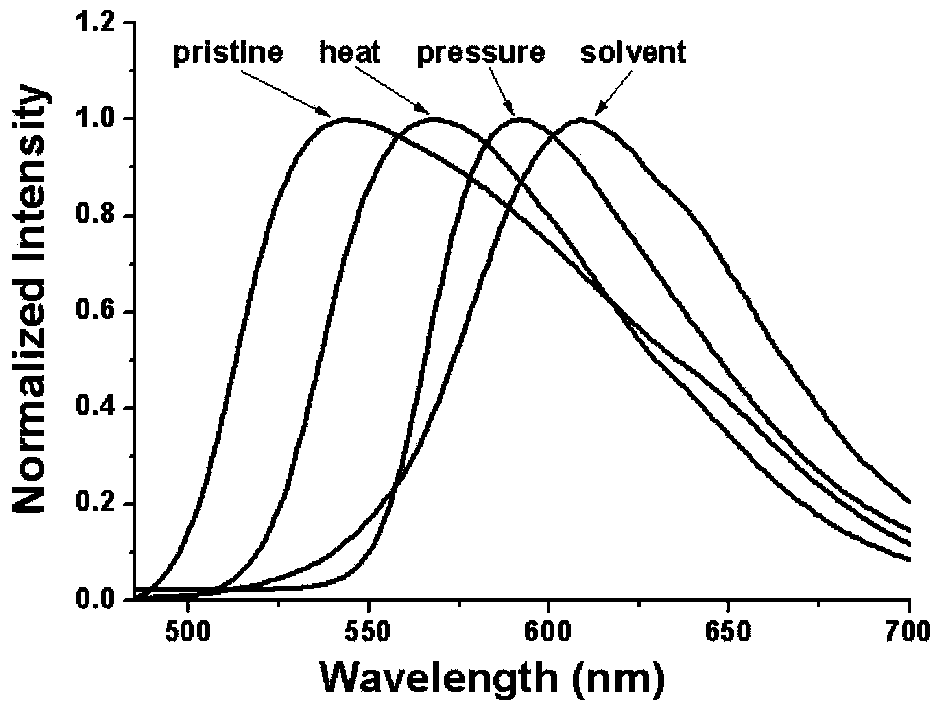Method for preparing multiple-stimulation respond material containing thienylmaleimide by virtue of two-step process
A multi-stimulus response, maleimide technology, applied in luminescent materials, color-changing fluorescent materials, chemical instruments and methods, etc., can solve the problem of lack of sufficient understanding of the piezochromic mechanism, and achieve high solid-state fluorescence quantum efficiency. , the synthesis steps are simple, and the thermal stability is good.
- Summary
- Abstract
- Description
- Claims
- Application Information
AI Technical Summary
Problems solved by technology
Method used
Image
Examples
Embodiment 1
[0029] 1) Preparation of 3,4-dibromomaleimide:
[0030] Put 3.88 g of maleimide (40 mmol) in a high pressure reaction flask, add 20 ml of N,N-dimethylformamide, then add 4.62 ml of bromine (90 mmol), seal the high pressure Heating the mouth of the reaction bottle to 58°C, gradually a light yellow solid was produced. After 48 hours of reaction, stop heating and return to room temperature, add 100 ml of water and 60 ml of dichloromethane for suction filtration, and obtain 3, 4-dibromomaleimide;
[0031] 2) Preparation of 3,4-bis(2'-thienyl)maleimide:
[0032] Put 0.51 g of 3,4-dibromomaleimide (2 mmol) and 7.02 mg of bistriphenylphosphine palladium dichloride catalyst (0.01 mmol) into a 25 ml two-necked flask, vacuumize, Infuse nitrogen gas, repeat pumping and irrigation three times, inject 1.27 ml of 2-tributylstannylthiophene (4 mmol) and 10 ml of N,N-dimethylformamide with a syringe, raise the temperature to 100°C, and react for 12 hours , stop heating and drop back to room ...
Embodiment 2
[0037] 1) Preparation of 3,4-dichloromaleimide:
[0038] Put 3.88 g of maleimide (40 mmol) in a high-pressure reaction flask, add 25 ml of N,N-dimethylformamide, then add 5.81 ml of thionyl chloride (80 mmol), seal Close the mouth of the high-pressure reaction bottle and heat it to 58°C. Gradually, a light yellow solid is produced. After 54 hours of reaction, stop heating and return to room temperature. Add 125ml of water and 75ml of dichloromethane successively for suction and filtration to obtain 3 , 4-dichloromaleimide;
[0039] 2) Preparation of 3,4-bis(2'-thienyl)maleimide:
[0040] Put 0.33 g of 3,4-dichloromaleimide (2 mmol) and 35.10 mg of bistriphenylphosphine palladium dichloride catalyst (0.05 mmol) into a 25 ml two-necked flask, vacuumize, Infuse nitrogen, repeat pumping and irrigation three times, inject 2.54 ml of 2-tributylstannylthiophene (8 mmol) and 10 ml of anhydrous N,N-dimethylformamide with a syringe, raise the temperature to 100°C, and react At 12 hou...
Embodiment 3
[0042] 1) Preparation of 3,4-dibromomaleimide:
[0043] Put 3.88 g of maleimide (40 mmol) in a high pressure reaction bottle, add 30 ml of N,N-dimethylformamide, then add 5.13 ml of bromine (100 mmol), seal the high pressure Heating the mouth of the reaction bottle to 58°C, gradually a light yellow solid was produced. After 72 hours of reaction, stop heating and return to room temperature, add 150 ml of water and 90 ml of dichloromethane for suction and filtration to obtain 3, 4-dibromomaleimide;
[0044] 2) Preparation of 3,4-bis(2'-thienyl)maleimide:
[0045] Put 0.51 g of 3,4-dibromomaleimide (2 mmol) and 3.51 mg of bistriphenylphosphine palladium dichloride catalyst (0.005 mmol) into a 25 ml two-necked flask, vacuumize, Infuse with nitrogen, repeat pumping and irrigation three times, inject 3.81 ml of 2-tributylstannylthiophene (12 mmol) and 10 ml of N,N-dimethylformamide with a syringe, raise the temperature to 100°C, and react for 12 hours , stop heating and return to...
PUM
 Login to View More
Login to View More Abstract
Description
Claims
Application Information
 Login to View More
Login to View More - R&D
- Intellectual Property
- Life Sciences
- Materials
- Tech Scout
- Unparalleled Data Quality
- Higher Quality Content
- 60% Fewer Hallucinations
Browse by: Latest US Patents, China's latest patents, Technical Efficacy Thesaurus, Application Domain, Technology Topic, Popular Technical Reports.
© 2025 PatSnap. All rights reserved.Legal|Privacy policy|Modern Slavery Act Transparency Statement|Sitemap|About US| Contact US: help@patsnap.com



